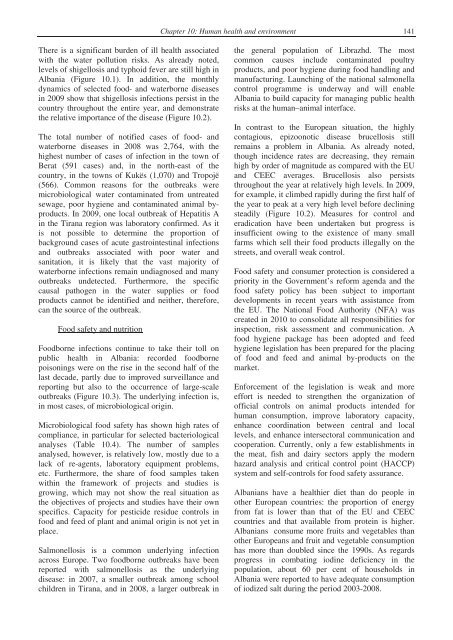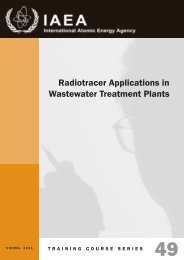Second Environmental Performance Review of Albania
Second Environmental Performance Review of Albania
Second Environmental Performance Review of Albania
You also want an ePaper? Increase the reach of your titles
YUMPU automatically turns print PDFs into web optimized ePapers that Google loves.
Chapter 10: Human health and environment141There is a significant burden <strong>of</strong> ill health associatedwith the water pollution risks. As already noted,levels <strong>of</strong> shigellosis and typhoid fever are still high in<strong>Albania</strong> (Figure 10.1). In addition, the monthlydynamics <strong>of</strong> selected food- and waterborne diseasesin 2009 show that shigellosis infections persist in thecountry throughout the entire year, and demonstratethe relative importance <strong>of</strong> the disease (Figure 10.2).The total number <strong>of</strong> notified cases <strong>of</strong> food- andwaterborne diseases in 2008 was 2,764, with thehighest number <strong>of</strong> cases <strong>of</strong> infection in the town <strong>of</strong>Berat (591 cases) and, in the north-east <strong>of</strong> thecountry, in the towns <strong>of</strong> Kukës (1,070) and Tropojë(566). Common reasons for the outbreaks weremicrobiological water contaminated from untreatedsewage, poor hygiene and contaminated animal byproducts.In 2009, one local outbreak <strong>of</strong> Hepatitis Ain the Tirana region was laboratory confirmed. As itis not possible to determine the proportion <strong>of</strong>background cases <strong>of</strong> acute gastrointestinal infectionsand outbreaks associated with poor water andsanitation, it is likely that the vast majority <strong>of</strong>waterborne infections remain undiagnosed and manyoutbreaks undetected. Furthermore, the specificcausal pathogen in the water supplies or foodproducts cannot be identified and neither, therefore,can the source <strong>of</strong> the outbreak.Food safety and nutritionFoodborne infections continue to take their toll onpublic health in <strong>Albania</strong>: recorded foodbornepoisonings were on the rise in the second half <strong>of</strong> thelast decade, partly due to improved surveillance andreporting but also to the occurrence <strong>of</strong> large-scaleoutbreaks (Figure 10.3). The underlying infection is,in most cases, <strong>of</strong> microbiological origin.Microbiological food safety has shown high rates <strong>of</strong>compliance, in particular for selected bacteriologicalanalyses (Table 10.4). The number <strong>of</strong> samplesanalysed, however, is relatively low, mostly due to alack <strong>of</strong> re-agents, laboratory equipment problems,etc. Furthermore, the share <strong>of</strong> food samples takenwithin the framework <strong>of</strong> projects and studies isgrowing, which may not show the real situation asthe objectives <strong>of</strong> projects and studies have their ownspecifics. Capacity for pesticide residue controls infood and feed <strong>of</strong> plant and animal origin is not yet inplace.Salmonellosis is a common underlying infectionacross Europe. Two foodborne outbreaks have beenreported with salmonellosis as the underlyingdisease: in 2007, a smaller outbreak among schoolchildren in Tirana, and in 2008, a larger outbreak inthe general population <strong>of</strong> Librazhd. The mostcommon causes include contaminated poultryproducts, and poor hygiene during food handling andmanufacturing. Launching <strong>of</strong> the national salmonellacontrol programme is underway and will enable<strong>Albania</strong> to build capacity for managing public healthrisks at the human–animal interface.In contrast to the European situation, the highlycontagious, epizoonotic disease brucellosis stillremains a problem in <strong>Albania</strong>. As already noted,though incidence rates are decreasing, they remainhigh by order <strong>of</strong> magnitude as compared with the EUand CEEC averages. Brucellosis also persiststhroughout the year at relatively high levels. In 2009,for example, it climbed rapidly during the first half <strong>of</strong>the year to peak at a very high level before decliningsteadily (Figure 10.2). Measures for control anderadication have been undertaken but progress isinsufficient owing to the existence <strong>of</strong> many smallfarms which sell their food products illegally on thestreets, and overall weak control.Food safety and consumer protection is considered apriority in the Government’s reform agenda and thefood safety policy has been subject to importantdevelopments in recent years with assistance fromthe EU. The National Food Authority (NFA) wascreated in 2010 to consolidate all responsibilities forinspection, risk assessment and communication. Afood hygiene package has been adopted and feedhygiene legislation has been prepared for the placing<strong>of</strong> food and feed and animal by-products on themarket.Enforcement <strong>of</strong> the legislation is weak and moreeffort is needed to strengthen the organization <strong>of</strong><strong>of</strong>ficial controls on animal products intended forhuman consumption, improve laboratory capacity,enhance coordination between central and locallevels, and enhance intersectoral communication andcooperation. Currently, only a few establishments inthe meat, fish and dairy sectors apply the modernhazard analysis and critical control point (HACCP)system and self-controls for food safety assurance.<strong>Albania</strong>ns have a healthier diet than do people inother European countries: the proportion <strong>of</strong> energyfrom fat is lower than that <strong>of</strong> the EU and CEECcountries and that available from protein is higher.<strong>Albania</strong>ns consume more fruits and vegetables thanother Europeans and fruit and vegetable consumptionhas more than doubled since the 1990s. As regardsprogress in combating iodine deficiency in thepopulation, about 60 per cent <strong>of</strong> households in<strong>Albania</strong> were reported to have adequate consumption<strong>of</strong> iodized salt during the period 2003-2008.
















